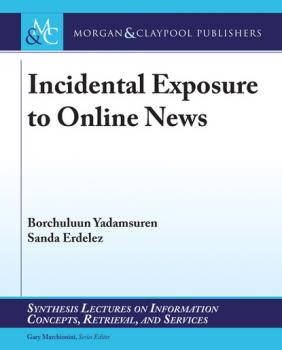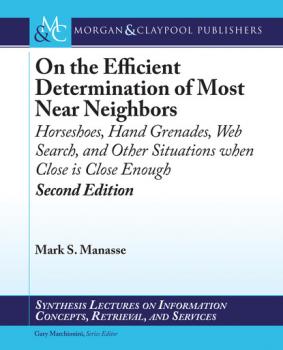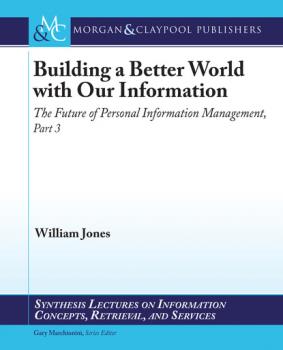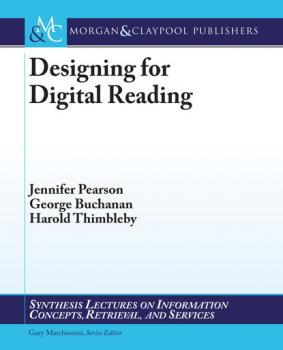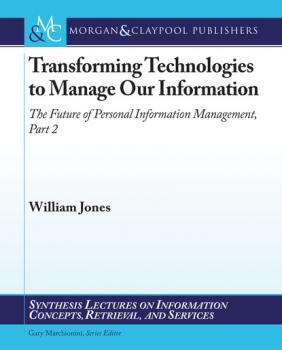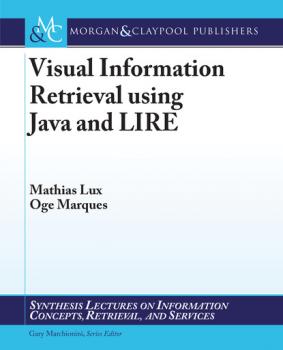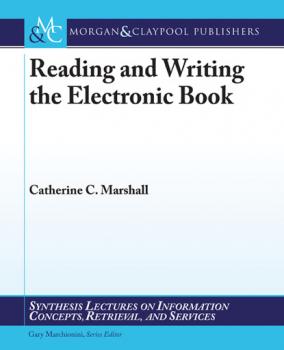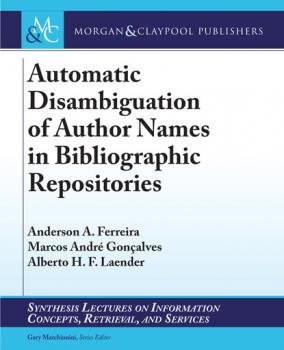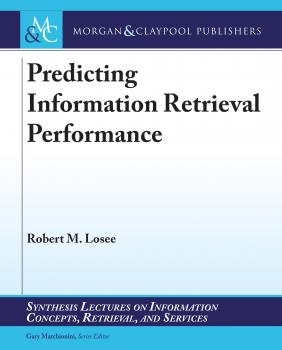ТОП просматриваемых книг сайта:
Synthesis Lectures on Information Concepts, Retrieval, and Services
Скачать книги из серии Synthesis Lectures on Information Concepts, Retrieval, and ServicesIncidental Exposure to Online News - Borchuluun Yadamsuren
Synthesis Lectures on Information Concepts, Retrieval, and ServicesАннотация
Информация о книге
Автор произведения Borchuluun Yadamsuren
Жанр Культурология
Серия Synthesis Lectures on Information Concepts, Retrieval, and Services
On the Efficient Determination of Most Near Neighbors - Mark S. Manasse
Synthesis Lectures on Information Concepts, Retrieval, and ServicesАннотация
This book is not devoted to sports discussions, but to efficient algorithms for determining pairs of closely related web pages—and a few other situations in which we have found that inexact matching is good enough – where proximity suffices. We will not, however, attempt to be comprehensive in the investigation of probabilistic algorithms, approximation algorithms, or even techniques for organizing the discovery of nearest neighbors. We are more concerned with finding nearby neighbors; if they are not particularly close by, we are not particularly interested.
In thinking of when approximation is sufficient, remember the oft-told joke about two campers sitting around after dinner. They hear noises coming towards them. One of them reaches for a pair of running shoes, and starts to don them. The second then notes that even with running shoes, they cannot hope to outrun a bear, to which the first notes that most likely the bear will be satiated after catching the slower of them. We seek problems in which we don't need to be faster than the bear, just faster than the others fleeing the bear.
Информация о книге
Автор произведения Mark S. Manasse
Жанр Компьютеры: прочее
Серия Synthesis Lectures on Information Concepts, Retrieval, and Services
Building a Better World with our Information - William Jones
Synthesis Lectures on Information Concepts, Retrieval, and ServicesАннотация
Информация о книге
Автор произведения William Jones
Жанр Программы
Серия Synthesis Lectures on Information Concepts, Retrieval, and Services
Designing for Digital Reading - Harold Thimbleby
Synthesis Lectures on Information Concepts, Retrieval, and ServicesАннотация
The physical properties of paper (for example, it is light, thin, and flexible) contribute to the ease with which physical documents are manipulated; but these properties have a completely different set of affordances to their digital equivalents. Paper can be folded, ripped, or scribbled on almost subconsciously – activities that require significant cognitive attention in their digital form, if they are even possible. The nearly subliminal interaction that comes from years of learned behavior with paper has been described as lightweight interaction, which is achieved when a person actively reads an article in a way that is so easy and unselfconscious that they are not apt to remember their actions later.
Reading is now in a period of rapid change, and digital text is fast becoming the predominant mode of reading. As a society, we are merely at the start of the journey of designing truly effective tools for handling digital text.
This book investigates the advantages of paper, how the affordances of paper can be realized in digital form, and what forms best support lightweight interaction for active reading. To understand how to design for the future, we review the ways reading technology and reader behavior have both changed and remained constant over hundreds of years. We explore the reasoning behind reader behavior and introduce and evaluate several user interface designs that implement these lightweight properties familiar from our everyday use of paper.
We start by looking back, reviewing the development of reading technology and the progress of research on reading over many years. Drawing key concepts from this review, we move forward to develop and test methods for creating new and more effective interactions for supporting digital reading. Finally, we lay down a set of lightweight attributes which can be used as evidence-based guidelines to improve the usability of future digital reading technologies. By the end of this book, then, we hope you will be equipped to critique the present state of digital reading, and to better design and evaluate new interaction styles and technologies.
Table of Contents: Preface / Acknowledgments / Figure Credits / Introduction / Reading Through the Ages / Key Concepts / Lightweight Interactions / Improving Digital Reading / Bibliography / Authors' Biographies
Информация о книге
Автор произведения Harold Thimbleby
Жанр Программы
Серия Synthesis Lectures on Information Concepts, Retrieval, and Services
Transforming Technologies to Manage Our Information - William Jones
Synthesis Lectures on Information Concepts, Retrieval, and ServicesАннотация
Part 2 provides a more focused look at technologies for managing information that promise to profoundly alter our practices of PIM and, through these practices, the way we lead our lives.
Part 2 is in five chapters:
– Chapter 5. Technologies of Input and Output. Technologies in support of gesture, touch, voice, and even eye movements combine to support a more natural user interface (NUI). Technologies of output include glasses and «watch» watches. Output will also increasingly be animated with options to «zoom».
– Chapter 6. Technologies to Save Our Information. We can opt for «life logs» to record our experiences with increasing fidelity. What will we use these logs for? And what isn’t recorded that should be?
– Chapter 7. Technologies to Search Our Information. The potential for personalized search is enormous and mostly yet to be realized. Persistent searches, situated in our information landscape, will allow us to maintain a diversity of projects and areas of interest without a need to continually switch from one to another to handle incoming information.
– Chapter 8. Technologies to Structure Our Information. Structure is key if we are to keep, find, and make effective use of our information. But how best to structure? And how best to share structured information between the applications we use, with other people, and also with ourselves over time? What lessons can we draw from the failures and successes in web-based efforts to share structure?
– Chapter 9. PIM Transformed and Transforming: Stories from the Past, Present and Future. Part 2 concludes with a comparison between Licklider’s world of information in 1957 and our own world of information today. And then we consider what the world of information is likely to look like in 2057. Licklider estimated that he spent 85% of his «thinking time» in activities that were clerical and mechanical and might (someday) be delegated to the computer. What percentage of our own time is spent with the clerical and mechanical? What about in 2057?
Table of Contents: Technologies of Input and Output / Technologies to Save Our Information / Technologies to Search Our Information / Technologies to Structure Our Information / PIM Transformed and Transforming: Stories from the Past, Present, and Future
Информация о книге
Автор произведения William Jones
Жанр Программы
Серия Synthesis Lectures on Information Concepts, Retrieval, and Services
Visual Information Retrieval using Java and LIRE - Mathias Lux
Synthesis Lectures on Information Concepts, Retrieval, and ServicesАннотация
The goal of VIR is to retrieve matches ranked by their relevance to a given query, which is often expressed as an example image and/or a series of keywords. During its early years (1995-2000), the research efforts were dominated by content-based approaches contributed primarily by the image and video processing community. During the past decade, it was widely recognized that the challenges imposed by the lack of coincidence between an image's visual contents and its semantic interpretation, also known as semantic gap, required a clever use of textual metadata (in addition to information extracted from the image's pixel contents) to make image and video retrieval solutions efficient and effective. The need to bridge (or at least narrow) the semantic gap has been one of the driving forces behind current VIR research. Additionally, other related research problems and market opportunities have started to emerge, offering a broad range of exciting problems for computer scientists and engineers to work on.
In this introductory book, we focus on a subset of VIR problems where the media consists of images, and the indexing and retrieval methods are based on the pixel contents of those images – an approach known as content-based image retrieval (CBIR). We present an implementation-oriented overview of CBIR concepts, techniques, algorithms, and figures of merit. Most chapters are supported by examples written in Java, using Lucene (an open-source Java-based indexing and search implementation) and LIRE (Lucene Image REtrieval), an open-source Java-based library for CBIR.
Информация о книге
Автор произведения Mathias Lux
Жанр Программы
Серия Synthesis Lectures on Information Concepts, Retrieval, and Services
Reading and Writing the Electronic Book - Catherine Marshall
Synthesis Lectures on Information Concepts, Retrieval, and ServicesАннотация
No book about ebooks is complete without an explicit discussion of content preparation, i.e., how the electronic book is written. Hence, Chapter 6 delves into the underlying representation of ebooks and efforts to create and apply markup standards to them. This chapter also examines how print genres have made the journey to digital and how some emerging digital genres might be realized as ebooks. Finally, Chapter 7 discusses some beyond-the-book functionality: how can ebook platforms be transformed into portable personal libraries? In the end, my hope is that by the time the reader reaches the end of this book, he or she will feel equipped to perform the next set of studies, write the next set of articles, invent new ebook functionality, or simply engage in a heated argument with the stranger in seat 17C about the future of reading.
Информация о книге
Автор произведения Catherine Marshall
Серия Synthesis Lectures on Information Concepts, Retrieval, and Services
Automatic Disambiguation of Author Names in Bibliographic Repositories - Marcos André Gonçalves
Synthesis Lectures on Information Concepts, Retrieval, and ServicesАннотация
Информация о книге
Автор произведения Marcos André Gonçalves
Жанр Программы
Серия Synthesis Lectures on Information Concepts, Retrieval, and Services
Predicting Information Retrieval Performance - Robert M. Losee
Synthesis Lectures on Information Concepts, Retrieval, and ServicesАннотация
Информация о книге
Автор произведения Robert M. Losee
Жанр Программы
Серия Synthesis Lectures on Information Concepts, Retrieval, and Services

